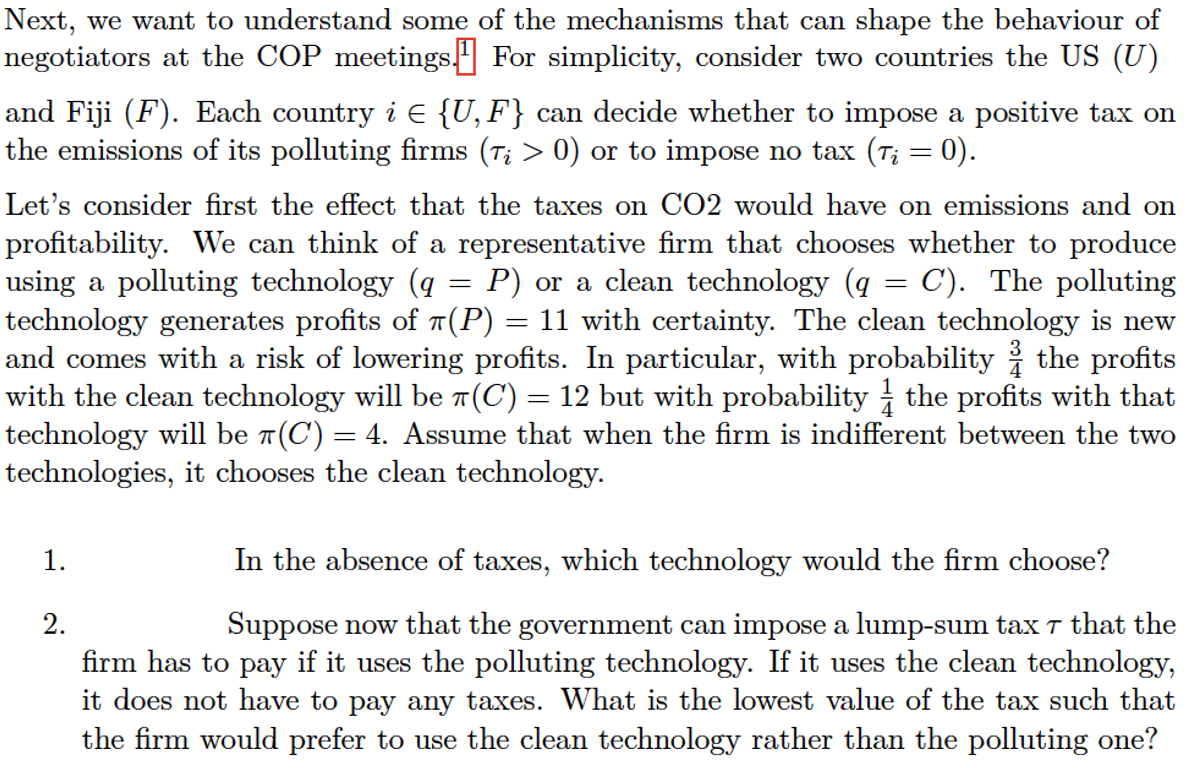Next, we want to understand some of the mechanisms that can shape the behaviour of negotiators at the COP meetings For simplicity, consider two countries the US (U) and Fiji (F). Each country i € {U, F} can decide whether to impose a positive tax on the emissions of its polluting firms (7¿ > 0) or to impose no tax (7¿ = 0). Let's consider first the effect that the taxes on CO2 would have on emissions and on profitability. We can think of a representative firm that chooses whether to produce using a polluting technology (q = P) or a clean technology (q = C). The polluting technology generates profits of (P) = 11 with certainty. The clean technology is new and comes with a risk of lowering profits. In particular, with probability the profits with the clean technology will be π(C) = 12 but with probability the profits with that technology will be π(C) = 4. Assume that when the firm is indifferent between the two technologies, it chooses the clean technology. 1. 2. In the absence of taxes, which technology would the firm choose? Suppose now that the government can impose a lump-sum tax 7 that the firm has to pay if it uses the polluting technology. If it uses the clean technology, it does not have to pay any taxes. What is the lowest value of the tax such that the firm would prefer to use the clean technology rather than the polluting one?
Next, we want to understand some of the mechanisms that can shape the behaviour of negotiators at the COP meetings For simplicity, consider two countries the US (U) and Fiji (F). Each country i € {U, F} can decide whether to impose a positive tax on the emissions of its polluting firms (7¿ > 0) or to impose no tax (7¿ = 0). Let's consider first the effect that the taxes on CO2 would have on emissions and on profitability. We can think of a representative firm that chooses whether to produce using a polluting technology (q = P) or a clean technology (q = C). The polluting technology generates profits of (P) = 11 with certainty. The clean technology is new and comes with a risk of lowering profits. In particular, with probability the profits with the clean technology will be π(C) = 12 but with probability the profits with that technology will be π(C) = 4. Assume that when the firm is indifferent between the two technologies, it chooses the clean technology. 1. 2. In the absence of taxes, which technology would the firm choose? Suppose now that the government can impose a lump-sum tax 7 that the firm has to pay if it uses the polluting technology. If it uses the clean technology, it does not have to pay any taxes. What is the lowest value of the tax such that the firm would prefer to use the clean technology rather than the polluting one?
Chapter1: Making Economics Decisions
Section: Chapter Questions
Problem 1QTC
Related questions
Question

Transcribed Image Text:Next, we want to understand some of the mechanisms that can shape the behaviour of
negotiators at the COP meetings For simplicity, consider two countries the US (U)
and Fiji (F). Each country i € {U, F} can decide whether to impose a positive tax on
the emissions of its polluting firms (T¿ > 0) or to impose no tax (7į = 0).
Let's consider first the effect that the taxes on CO2 would have on emissions and on
profitability. We can think of a representative firm that chooses whether to produce
using a polluting technology (q = P) or a clean technology (q = C). The polluting
technology generates profits of π(P) = 11 with certainty. The clean technology is new
and comes with a risk of lowering profits. In particular, with probability & the profits
with the clean technology will be π(C) = 12 but with probability the profits with that
technology will be π(C) = 4. Assume that when the firm is indifferent between the two
technologies, it chooses the clean technology.
1.
2.
In the absence of taxes, which technology would the firm choose?
Suppose now that the government can impose a lump-sum tax 7 that the
firm has to pay if it uses the polluting technology. If it uses the clean technology,
it does not have to pay any taxes. What is the lowest value of the tax such that
the firm would prefer to use the clean technology rather than the polluting one?
Expert Solution
This question has been solved!
Explore an expertly crafted, step-by-step solution for a thorough understanding of key concepts.
Step by step
Solved in 2 steps

Knowledge Booster
Learn more about
Need a deep-dive on the concept behind this application? Look no further. Learn more about this topic, economics and related others by exploring similar questions and additional content below.Recommended textbooks for you


Principles of Economics (12th Edition)
Economics
ISBN:
9780134078779
Author:
Karl E. Case, Ray C. Fair, Sharon E. Oster
Publisher:
PEARSON

Engineering Economy (17th Edition)
Economics
ISBN:
9780134870069
Author:
William G. Sullivan, Elin M. Wicks, C. Patrick Koelling
Publisher:
PEARSON


Principles of Economics (12th Edition)
Economics
ISBN:
9780134078779
Author:
Karl E. Case, Ray C. Fair, Sharon E. Oster
Publisher:
PEARSON

Engineering Economy (17th Edition)
Economics
ISBN:
9780134870069
Author:
William G. Sullivan, Elin M. Wicks, C. Patrick Koelling
Publisher:
PEARSON

Principles of Economics (MindTap Course List)
Economics
ISBN:
9781305585126
Author:
N. Gregory Mankiw
Publisher:
Cengage Learning

Managerial Economics: A Problem Solving Approach
Economics
ISBN:
9781337106665
Author:
Luke M. Froeb, Brian T. McCann, Michael R. Ward, Mike Shor
Publisher:
Cengage Learning

Managerial Economics & Business Strategy (Mcgraw-…
Economics
ISBN:
9781259290619
Author:
Michael Baye, Jeff Prince
Publisher:
McGraw-Hill Education